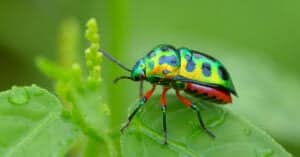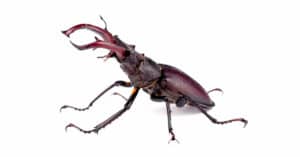Between 77 and 80 beetles are native to Hawaii. Residents of the Rainbow State probably wish it remained that way since they’ve witnessed the destructive nature of non-indigenous insects. Rhinoceros beetles showed up on Hawaiin shores around 2013 and have wreaked havoc on the island ever since.
In April of 2022, two new beetle species native to Hawaii were discovered, both of which are on the list below. Despite Hawaii’s isolation, discoveries hide around every corner.
Hawaii isn’t like every state when it comes to native species. It’s easier (though still difficult) to identify what is and isn’t native since Hawaii shares a border with no one. Our list only contains native beetles, including the brand-new members of Hawaii’s large (and growing) beetle family.
Tiny Beetles in Hawaii
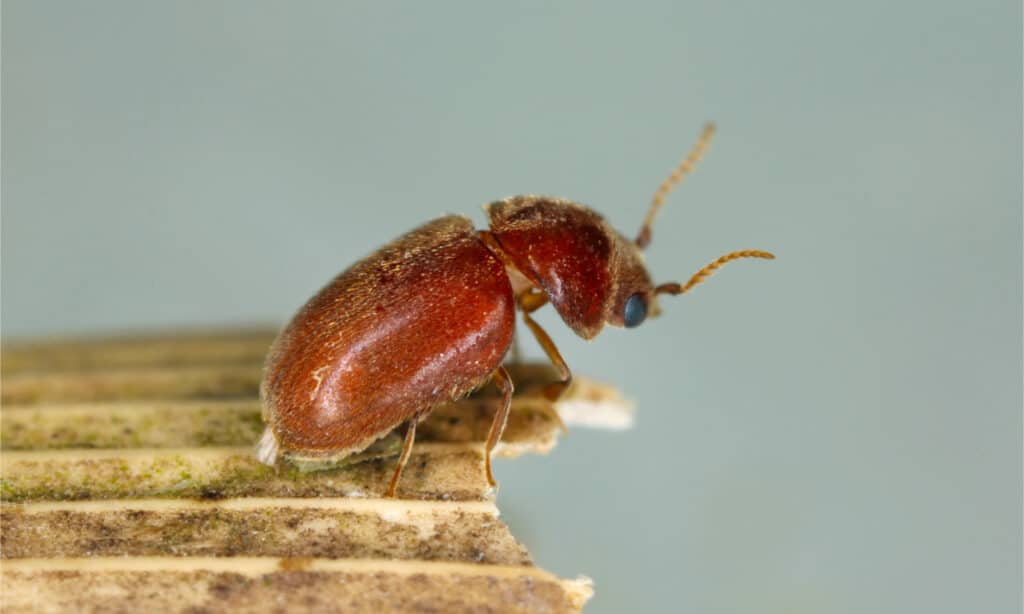
The cigarette beetle is a tiny creature, no larger than 1/8 of an inch. Their primary target is tobacco.
©Tomasz Klejdysz/Shutterstock.com
Since our main list contains mostly larger beetles, we wanted to take a second to highlight some of the smallest Hawaiian beetles. The cigarette beetle is a tiny creature, no larger than 1/8 of an inch. Their primary target is tobacco, and since they are so small, it’s often hard to recognize an infestation until it’s too late.
The merchant grain beetle is also very tiny, with adult males only reaching 1/10 of an inch. As its name implies, it is often found in grain, making it another species on the ‘infestation’ list. Last but not least, the infamous pest beetle known as the red flour beetle is super tiny at only 1/8 of an inch long. Hawaiians are intimately familiar with this obnoxious beetle.
Now that the little guys have been appropriately recognized, let’s move on to our list of beetles native to Hawaii!
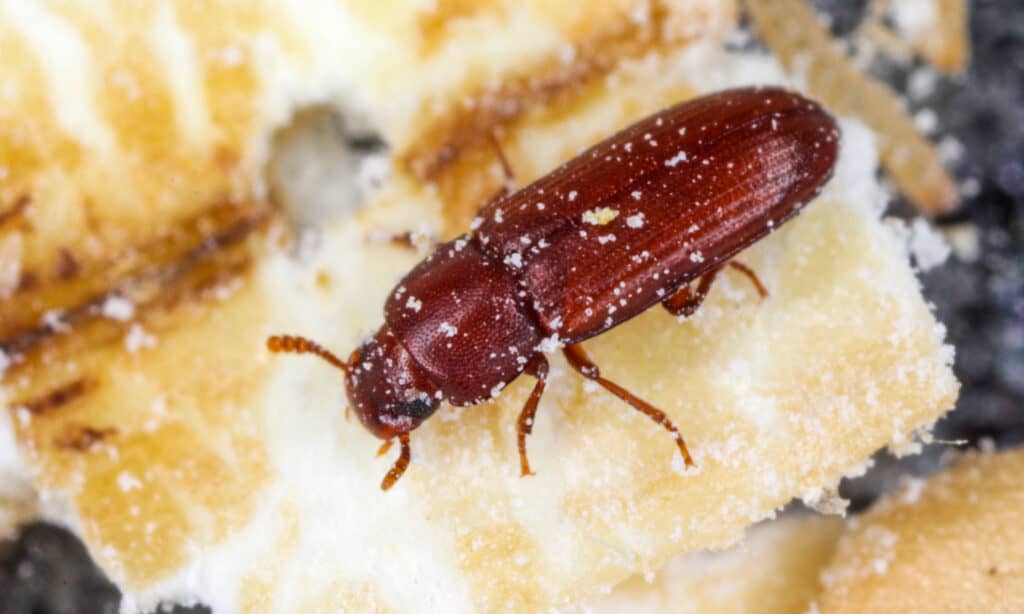
The infamous pest beetle known as the red flour beetle is super tiny at only 1/8 of an inch long.
©Tomasz Klejdysz/Shutterstock.com
1. Mecyclothorax Neonomas
There is no common name for this newly discovered beetle. Dr. Kip Will and Dr. James Leibherr found this insect only last year. It falls under the ground beetle category.
The mecyclothorax neonomas belongs to a group of carabids and, to the untrained eye, looks a lot like most other beetles in Hawaii. The beetle is a standard brown color with an ant segmentation appearance to its front half and a decidedly beetle-like abdomen that’s squared, with rounded corners.
There are a series of lines running the length of the abdomen, and it has long translucent antennae. In a lot of ways, it resembles a cockroach, though it lacks the size of a typical, Hawaiian cockroach (Hawaiian cockroaches grow to palm-size proportions).
2. Golden Tortoise Beetle
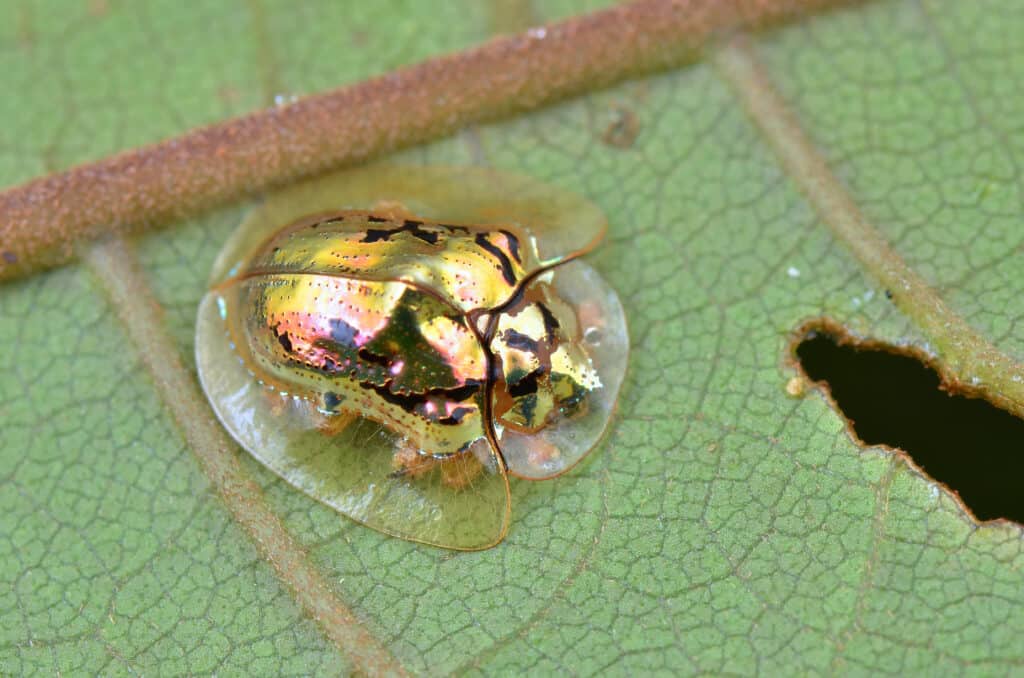
Their shimmering bodies resemble two gold plates split by a tiny line down the center.
©SIMON SHIM/Shutterstock.com
The golden tortoise beetle stands out in a crowd thanks to its gold-plated appearance. Their shimmering bodies resemble two gold plates split by a tiny line down the center. They aren’t very big, only reaching .25″ in length. However, they are certainly noticeable.
This beetle is capable of changing colors when necessary for self-defense. Though the shiny, mirror-like golden armor is the most common, the golden tortoise beetle can switch to a variety of red-browns and yellows.
They aren’t a damaging species, although they do enjoy eating holes in leaves. One of their most interesting features is their ability to play dead when threatened.
3. Dogbane Leaf Beetle

The dogbane is a bright, reflective, striking green metallic color.
©Gerry Bishop/Shutterstock.com
Speaking of metallic beetles, the dogbane leaf beetle is more than worthy of competing with the golden tortoise beetle for the best shiny appearance. The dogbane is a bright, reflective, green metallic rather than gold, but it’s no less striking.
It’s often overlooked because of its tiny size, which is half that of the golden tortoise. As their name implies, dogbane beetles spend the vast majority of their short lives living on the dogbane plant. They eat, sleep, breed, and die there. This plant is an excellent choice of home since it’s toxic to most predators, especially to carnivores.
Female dogbane leaf beetles spend most of their life defecating at the bottom of the plant, and eventually, they lay their eggs in their poo. Newly emerging dogbane beetles eat feces for nutrition. Fun stuff.
4. Stag Beetle Aegolipton Reflexum
The scientific name is necessary to include with the common name because there are only two stag beetle species native to Hawaii. The aegolipton reflexum is a very rare stag beetle from the Lucanidae family.
It has a streamlined, cockroach appearance, with a fuzzy, light brown back that darkens as the colorations move towards the head. They have very long antennae, and they aren’t exactly the prettiest species of beetle in the world.
It’s a borer-type insect, capable of infesting. However, there aren’t enough of them left to create any kind of infestation-level event. They are so exquisitely rare that it’s difficult to find much information on them.
5. Kiawe Roundheaded Borers
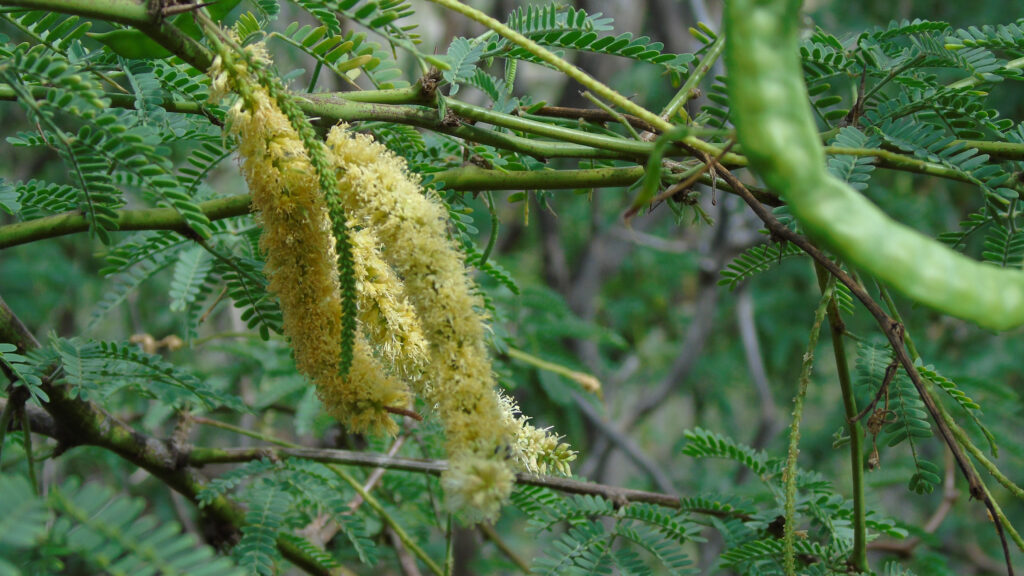
The Kiawe roundheaded borer uses the Kiawe plant as its host plant, from which it derives its name.
©iStock.com/samuel howell
This pretty beetle is also roundly loathed by Hawaiians. The beetle’s undercover is a shiny black, with the entire body speckled in bright yellow spots.
It uses the Kiawe plant as its host plant, from which it derives its name. Hawaii considers it a highly destructive species and local pest control attempts to eradicate it wherever it’s found. Once they reach adulthood, they are highly attracted to rotten leaves and felled trees.
Homeowners hate them because they bore into wood—any kind of wood. That means porches, homes, businesses, decks, shops, and exterior garages. If it has wood, it’s susceptible to the Kiawe roundheaded borer.
6. Hawaiian Endemic Bark Beetle
The Hawaiian endemic bark beetle is a destructive forest beetle recently rediscovered in Hawaii. Only about .20″ long, the all-black bark beetle is one of several bark beetle species.
As their name implies, bark beetles burrow underneath the bark of a tree and set up shop. The problem with the Hawaiian bark beetle is that it goes after healthy trees, as well as rotten trees.
They infest entire forested regions and endanger the health of the trees in the area. It would seem that Hawaii is rife with destructive species of beetles!
7. False Blister Beetle
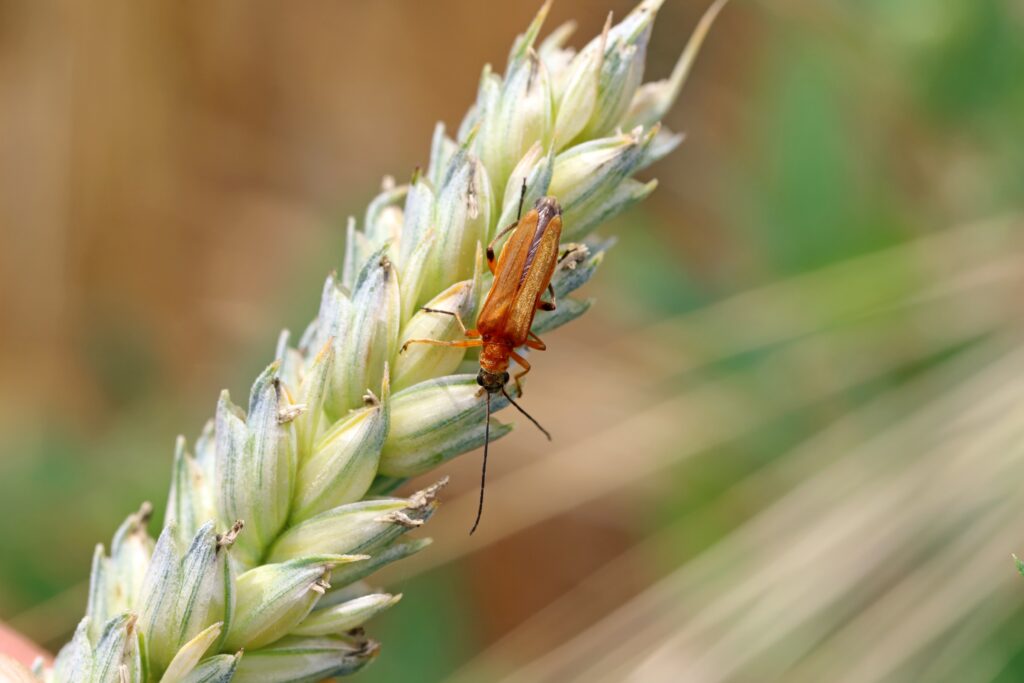
The drug known as ‘Spanish Fly’ is derived from this blistering agent that oozes from the beetle when it’s under threat.
©Tomasz Klejdysz/Shutterstock.com
There is nothing false about this beetle’s blistering capabilities. Although the chemicals they excrete can cause blisters, false blister beetles aren’t destructive or invasive. Interestingly, the drug known as ‘Spanish Fly’ is derived from this blistering agent that oozes from the beetle when it’s under threat.
Also known as pollen-feeding beetles, the false blister beetle is about .20″ in length and can be a variety of colors, including a hazy green, brownish-black, tan, or reddish-brown.
For the most part, they’re relatively harmless unless you decide to pick one up. Each individual’s skin reacts differently to chemical secretion. While some experience a nasty little blister, others may come away with nothing more than a red, slightly irritated spot.
8. Kauai Flightless Stag Beetle
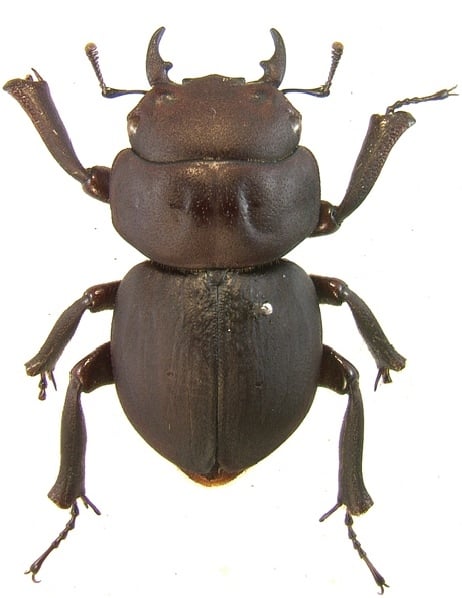
This black beetle is restricted to the island of Kauai, hence the name.
©M.J. Paulsen, David C. Hawks/CC BY-SA 4.0 – License
The Kauai flightless stag beetle has an extreme segmentation appearance between its front and back halves and is dark brown in appearance. it is the smallest of its kind yet still a decent size for an insect at roughly 3/4 of an inch in length.
They enjoy native forest living but only at extended elevations. Suffice it to say, most native Hawaiians don’t run into the Kauai flightless stag beetle unless they decide to hike at high altitudes.
It was discovered and annotated by explorers from the British Natural History Museum. This beetle is restricted to the island of Kauai, hence the name. It features a glossy, non-descript black body.
9. Pitchy Scarab Beetle
The pitchy scarab beetle is the quintessential beetle. It’s the exact shape, size, and color of the stereotypical beetle.
It has a blocky, glossy black body with faint lines running the length of the thorax. It features a single segmentation that’s barely distinguishable along the upper third of its body. Some appear as a very dark brown. This beetle is essentially a dung beetle, surviving on the feces of the local wildlife.
It’s also known as a ‘scarab beetle,’ a class of beetles that are becoming problematic in Hawaii.
10. Varied Carpet Beetle
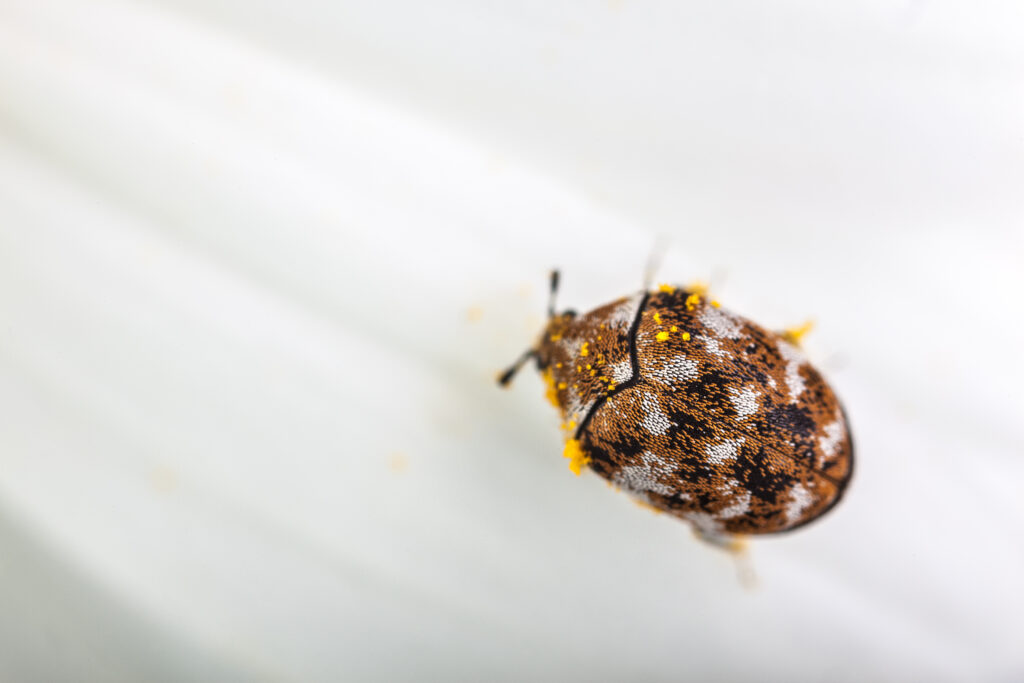
They are uniquely patterned and buck the trend insofar as beetle markings go.
©iStock.com/porpeller
Varied carpet beetles are a fairly common species, and it’s on the small side, only measuring less than 1/10 of an inch. They are uniquely patterned and buck the trend insofar as beetle markings go.
Varied carpet beetles have a fairly long life span of one to three years, especially when you compare them to other beetles. They also love keratin, which is why they are so destructive. Keratin is found in human and pet hair, which inevitably finds its way into the carpet. The varied carpet beetle comes along and chews the carpet to pieces. For this reason, varied carpet beetles are infamous in Hawaii, as well as in any other area they inhabit.
All Things Considered
Just because Hawaii sits way out in the Pacific Ocean, far from the rest of the United States, doesn’t mean the island lacks beetle varieties. And with a booming tourism industry, Hawaii is liable to end up with a lot more beetles sooner rather than later.
Hawaii is home to an abundance of beautiful wildlife, including beetles. Though some are invasive, and/or destructive, these wonderous creatures are a part of the natural environment in Hawaii.
The photo featured at the top of this post is © Silmiart/Shutterstock.com
Thank you for reading! Have some feedback for us? Contact the AZ Animals editorial team.



